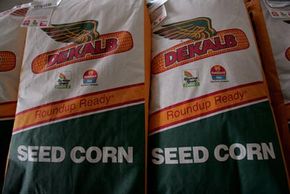Ethanol Feedstocks
Ethanol is a fuel made from the fermentation and distillation of sugars and starches. In short, it means running your car on alcohol. Feedstocks are the basic components of ethanol. Just as different foods give your body more or less energy, so will different stock plants make for better ethanol. Everybody's heard about making ethanol from corn. Corn, however, doesn't put out nearly the yield of energy that sugar does. Sugar cane isn't a common crop in the United States, so that particular feedstock could actually make our situation worse if we tried to use it. Just imagine the gas we'd use just to ship the cane! The key to making great ethanol is to find feedstock close to you and make it work.
While there is plenty of corn in the Midwest, the Southeast and Northwest are better known for logging industries. Ethanol distilleries in these states use leftover wood chips and tree parts to produce ethanol. If you live on a farm, you can use leftover straw, husks and grain. If you can manage this, not only are you recycling your waste into something useful, you're cutting down on a chunk of your overall fuel costs. Your feedstock is free!
Advertisement
If you don't have this sort of useful waste available and need to grow your own feedstock, do a little research before running off to buy corn. There are plenty of crops that grow well in different regions and make for better fuel. For example, one acre of corn can be processed into about 330 gallons of ethanol, while one acre of switchgrass can be processed into about 1,150 gallons of ethanol a year! [source: Bioenergy]
Now that you've got your feedstock, you'll need to ferment it. Fermentation is a simple process:
sugary/starchy foods + yeast = alcohol and CO2
sugary/starchy foods + yeast = alcohol and CO2
The yeast is living bacteria that eat the sugar or starch and excrete alcohol and carbon dioxide in the fermentation process. Think of that the next time you drink a beer!
Once your ethanol has fermented, you will have a mixture that is a combination of ethanol and its byproduct, water. Since you can't burn water in an engine, you will need to remove it through a process called distillation.
Want to know how to separate ethanol from water? Read the next page to find out.
